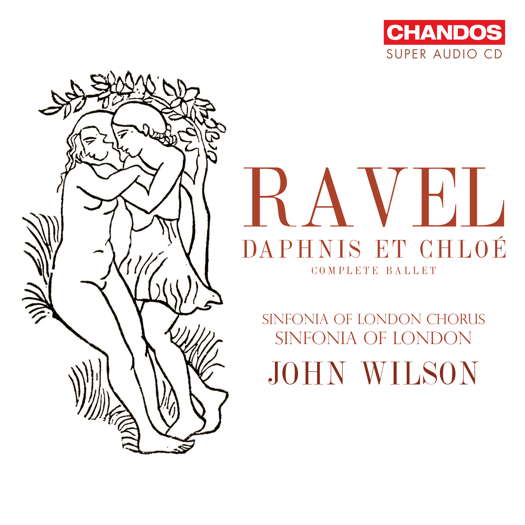- Ben Britten
- operetta
- Giuseppe Sinopoli
- Sterling Records
- Gounod
- Lowell Liebermann: Frankenstein
- English musical Renaissance
- Victoria BC

A Sparkling New Edition
Ravel's complete ballet 'Daphnis et Chloé', strongly recommended by GERALD FENECH
'Sound and presentation complement the music to the hilt.'
Maurice Ravel (1875-1937) composed Daphnis and Chloe between 1909 and 1912. We cannot consider the evolution and role of time - or the theme of desire - in twentieth century music without visiting Daphnis and Chloe. Conventions of rhythmic organization were becoming increasingly disregarded by the late nineteenth and early twentieth centuries, the most radical innovation being the distortion or outright avoidance of a clear beat. The opening of Ravel's ballet is a prime example of this development.
Listen — Ravel: Introduction (Daphnis et Chloé Part 1)
(CHSA 5327 track 1, 0:02-0:53) ℗ 2023 Chandos Records Ltd :
In 1909 Ravel accepted a commission from the Ballets Russes impresario Sergei Diaghilev to produce a score for one of their new ballets - a new version of an ancient Greek tale that had been popular in France since the Renaissance. The composer described his score as 'a choreographic symphony in three parts where the intention was to write a vast musical fresco, less scrupulous as to archaism than faithful to the Greece of my dreams'.
Daphnis received a lukewarm reception at its premiere at the Théâtre du Châtelet on 8 June 1912, but Ravel did not lose heart. Soon after, he published two concert suites derived from the original score which encapsulate the complete score.
The plot: Daphnis and Chloe are innocent characters in an ancient pastoral setting. On a spring day, shepherds worship at the alter of the nymphs, and shepherdesses dance enticingly around Daphnis, arousing Chloe's jealousy. She, in turn, is approached suggestively by a cowherd. Nonetheless, the attraction between the two lovers remains intact, but suddenly, Chloe is abducted by pirates. Part One ends with the god Pan being summoned to help retrieve her. Part Two of the ballet shifts to the pirates' lair, but they scatter when Pan arrives leading an army of fauns. After the 'Daybreak' section described above, Chloe awakes to find herself transported to be reunited with Daphnis in Pan's grotto. They thank him by dancing a re-enactment of Pan's love for Syriux. After they swear eternal fidelity, everybody joins in with a Danse generale that explodes into a frenzied bacchanale.
Listen — Ravel: Bacchanale (Daphnis et Chloé Part 3)
(CHSA 5327 track 14, 0:00-0:46) ℗ 2023 Chandos Records Ltd :
The work is constructed symphonically according to a strict tonal path, by means of a small number of motifs, whose development assures the symphonic homogeneity of the piece. Leitmotifs do run through the entire score and, as the composer suggests, a tonal plan does govern this overwhelmingly A-major work, though its strictness may be obscured by the ballet's length and its generally rhapsodic flavour.
Listen — Ravel: Nocturne (Daphnis et Chloé Part 1)
(CHSA 5327 track 8, 0:00-0:59) ℗ 2023 Chandos Records Ltd :
At this stage I would like to ask one question. Do you think that for the past hundred years plus we have been hearing Daphnis and Chloe in the true version of the composer? Well, this is what conductor John Wilson has to say about his new performing edition:
The standard performing materials for 'Daphnis and Chloe' have long been the subject of much discussion among orchestral players, conductors and musicologists. Aside from a mass of errors in the 1913 published full score, the orchestral parts contain hundreds of inconsistencies, omissions and wrong notes. It became apparent that numerous changes made by Ravel in rehearsals were transferred directly into the parts but not carried over in the full score. I have tried to rationalize such inconsistencies as best I could to arrive at what is, I hope, a useful practical performing edition in which the parts match the full score in every detail and - crucially, for a work of such complexity - everything is carefully laid out and easy to read.
Listen — Ravel: Danse suppliante de Chloé (Daphnis et Chloé Part 2)
(CHSA 5327 track 11, 4:18-5:05) ℗ 2023 Chandos Records Ltd :
This is a sparkling new edition of a sonic spectacular that would have certainly got the nod from Ravel himself. Sound and presentation complement the music to the hilt. Strongly recommended, especially for Ravel admirers.
Copyright © 23 October 2023
Gerald Fenech,
Gzira, Malta





